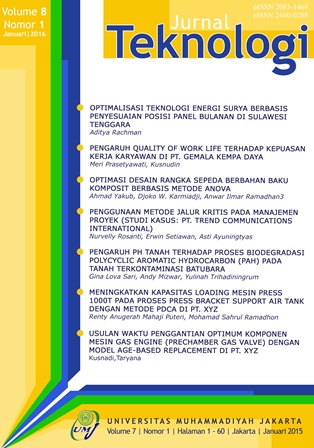PENGGUNAAN METODE JALUR KRITIS PADA MANAJEMEN PROYEK (STUDI KASUS: PT. TREND COMMUNICATIONS INTERNATIONAL)
Main Article Content
Abstract
Downloads
Article Details
COPYRIGHT POLICY
The author(s) of an article published in the Jurnal Teknologi retains ownership of the intellectual property rights in work (s).
PUBLISHING RIGHTS
The author(s) of an article published in the Jurnal Teknologi have unrestricted publication rights. The authors give the Jurnal Teknologi the right to publish the article and designate the Faculty of Engineering Universitas Muhammadiyah Jakarta Publishing as the original publisher of the article.
LICENSING POLICY
Journal of Mechanical Engineering and Sciences is an open-access journal that follows the Creative Commons Non-Commercial 4.0 International License (CC BY-NC 4.0), which states that:

Under this license, the reusers must give appropriate credit, provide a link to the license, and indicate if changes were made. Users may do so in any reasonable manner, but not in any way that suggests the licensor endorses users or their use.
Please take the time to read the whole license agreement (https://creativecommons.org/licenses/by-nc/4.0/). As long as reusers follow the license conditions, the owner cannot withdraw these freedoms. The following components are included under this license:
 Attribution: Users must provide appropriate attribution, including a link to the license, and indicate whether or not they made any modifications. Users are free to do so reasonably, but not in a manner that indicates the licensee approves of their usage.
Attribution: Users must provide appropriate attribution, including a link to the license, and indicate whether or not they made any modifications. Users are free to do so reasonably, but not in a manner that indicates the licensee approves of their usage.
 NonCommercial: Users may not use the material for commercial purposes.
NonCommercial: Users may not use the material for commercial purposes.
References
Project Management Institute. 2009. Project Management Body of Knowledge (4th Edition). Project Management Institute. Pennsylvania, USA.
Mosaic Project Services. 2007. The Origins of Modern Project Management. Mosaic Project Services. Melbourne.
Baker, Samuel L. 2004. Critical Path Method (CPM). http://hspm.sph.sc.edu/COURSES/J716/CPM/CPM.html, diakses 14 Desember 2014).
De Weck, Olivier. 2012. Critical Path Method (CPM) (ocw.mit.edu/.../MITESD_36F12_Lec02.pdf, diakses 14 Desember 2014).
Sommerville, Ian. 2011. Software Engineering (9th Edition). Pearson. Boston, Massachusettes, USA.
Solichin, Achmad. 2009. Pemrograman Web dengan PHP dan MySQL.

